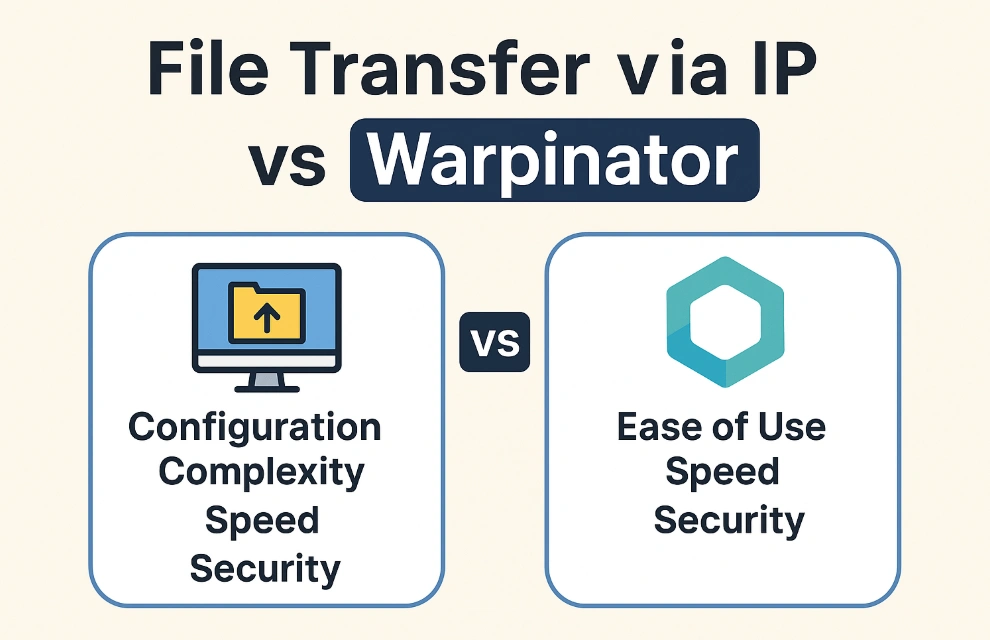Fast and secure file transfer is essential nowadays. There are multiple ways to transfer files between devices. But two popular methods are direct file transfer via IP and using the Warpinator app. Here is a comprehensive discussion to compare these two approaches in terms of ease of use, speed, security, and reliability.
Comparison Table: File Transfer via IP vs Warpinator
| Feature | File Transfer via IP | Warpinator |
|---|---|---|
| Setup Requirements | Manual network configuration, IP addressing, firewall adjustments, protocol selection | Minimal setup, automatic device discovery, simple local network connectivity |
| Ease of Use | Requires command-line knowledge and network expertise | Graphical interface, intuitive for non-technical users |
| Transfer Speed | Dependent on protocol, network latency, and bandwidth | Optimized for LAN, fast for small-to-medium files |
| Security and Privacy | Supports encrypted protocols like SSH/SFTP but requires configuration | End-to-end encryption on local network, minimal external exposure |
| Compatibility | Cross-platform: Windows, Linux, macOS | Linux-native, Windows/Mac clients require extra setup |
| Troubleshooting and Reliability | Prone to misconfiguration, firewall issues, network errors | Automated device detection, robust error handling, reliable connectivity |
| Best Use Cases | Cross-platform sharing, remote access, large files | Local network sharing, Linux devices, quick file exchange |
You can also read: Warpinator Over Wi-Fi vs Ethernet: Which Is Faster?
1. Setup Requirements
File transfer via IP demands manual network configuration, including IP addressing, firewall adjustments, and protocol selection. Warpinator minimizes setup complexity, providing automatic device discovery and streamlined local network connectivity for rapid deployment.
IP: Requires knowledge of IP addresses, network configuration, and permissions.
Warpinator: Simple installation with minimal network setup.
2. Ease of Use
IP-based transfers require advanced knowledge of command-line operations and network topology. Warpinator provides a graphical interface that simplifies device discovery and file exchange, reducing the technical barrier for end users.
IP: More technical steps may require command-line knowledge.
Warpinator: GUI-based, intuitive interface for non-technical users.
3. Transfer Speed
IP-based transfer performance is influenced by network protocols, latency, and bandwidth constraints. Warpinator optimizes throughput for LAN environments, often achieving superior speeds for small to medium file sizes with minimal overhead.
IP: Dependent on network protocol (SFTP, FTP, SMB) and network speed.
Warpinator: Optimized for local networks, often faster for small-to-medium files.
4. Security and Privacy
IP transfer supports encrypted protocols like SSH/SFTP but requires manual configuration. Warpinator enforces end-to-end encryption within local networks, limiting external exposure and simplifying secure file exchange for non-expert users.
IP: Secure protocols available but require configuration (SFTP, SSH).
Warpinator: Encrypted transfers, local network only, minimal exposure to external threats.
5. Compatibility
IP transfer protocols are cross-platform, functioning across Windows, Linux, and macOS environments. Warpinator is primarily Linux-native, with limited client support for Windows and macOS, requiring additional installation steps for interoperability.
IP: Works across different OS (Windows, Linux, macOS) with proper setup.
Warpinator: Native to Linux; Windows/Mac clients available, but may need additional steps.
6. Troubleshooting and Reliability
IP transfers are susceptible to misconfiguration, firewall conflicts, and network interruptions. Warpinator provides automated device detection and robust error handling, ensuring consistent connectivity and reducing operational troubleshooting requirements.
IP: Can be prone to misconfigurations, firewall issues, or network errors.
Warpinator: Mostly hassle-free, handles connectivity automatically.
7. Best Use Cases
IP-based transfer is optimal for cross-platform sharing, remote access, and large file distribution. Warpinator excels in LAN-based environments, facilitating rapid, user-friendly file sharing between multiple Linux devices with minimal configuration.
IP: Ideal for cross-platform transfers, large files, or remote access.
Warpinator: Ideal for local networks, fast sharing between Linux devices.
Conclusion
Both file transfer via IP and Warpinator have their strengths and weaknesses. IP transfer is flexible and suitable for remote access, while Warpinator offers a simple, user-friendly solution for local network file sharing. Choosing the right method depends on your technical knowledge, network environment, and file transfer needs.
